The Green Hornet Kato & Black Beauty Interview
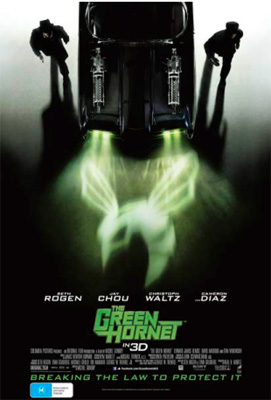
The Green Hornet
Cast: Seth Rogen, Jay Chou, Cameron Diaz, Christoph Waltz, Edward James Olmos, David Harbour and Tom WilkinsonDirector: Michel Gondry
Genre: Action
Running Time: 119 mins
Synopsis:
In the 3D action-comedy The Green Hornet, Britt Reid (Seth Rogen) is the son of LA's most prominent and respected media magnate and perfectly happy to maintain a directionless existence on the party scene - until his father (Tom Wilkinson) mysteriously dies, leaving Britt his vast media empire. Striking an unlikely friendship with one of his father's more industrious and inventive employees, Kato (Jay Chou), they see their chance to do something meaningful for the first time in their lives: fight crime. But in order to do this, they decide to become criminals themselves - protecting the law by breaking it, Britt becomes the vigilante The Green Hornet as he and Kato hit the streets.
Using all his ingenuity and skill, Kato builds the ultimate in advanced retro weaponry, The Black Beauty, an indestructible car equal parts firepower and horsepower. Rolling in a mobile fortress on wheels and striking the bad guys with Kato's clever gadgets, The Green Hornet and Kato quickly start making a name for themselves, and with the help of Britt's new secretary, Lenore Case (Cameron Diaz), they begin hunting down the man who controls LA's gritty underworld: Benjamin Chudnofsky (Christoph Waltz). But Chudnofsky has plans of his own: to swat down The Green Hornet once and for all.
The Green Hornet Review
Seth Rogan - The Green Hornet Interview
The Green Hornet
Release Date: January 20, 2011
www.thegreenhornet.com.au
ABOUT BLACK BEAUTY
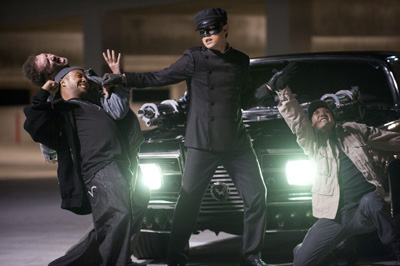 "As far as I'm concerned," says producer Neal H. Moritz, "the Black Beauty is the third of the threesome. She is the superhero of the movie."
"As far as I'm concerned," says producer Neal H. Moritz, "the Black Beauty is the third of the threesome. She is the superhero of the movie."Just like the rest of the characters in The Green Hornet, the Black Beauty had to be cast. In the casting process, several cars auditioned, and the filmmakers were not sentimental during the process.
"We really looked at making a lot of different cars," Neal H. Moritz goes on. "We had different manufacturers who wanted to build a new Black Beauty, and we considered many different cars."
"We didn't want it to be too futuristic," says Michel Gondry. "There was very little CG that would work for the car. We wanted it to feel real - a real car, with a real solid engine."
When at last the Imperial was suggested and agreed upon, it seemed like the natural choice. "The Imperial was definitely my preference from the beginning when I first got on the project," says picture car captain Dennis McCarthy, who had worked with Neal H. Moritz on the Fast and Furious films. "And once it was suggested, we did a quick show-and-tell for Neal, Michel, and Seth, and that pretty much sold it right there."
Of course, in its time, the Chrysler Imperial was the top of the line, but some 40 years have passed. During the run of the television series, the Black Beauty had custom details, including shaved-off bumpers and chrome. "We went for a little more classic look," says McCarthy. "We left the chrome bumpers on the car, we left the chrome trim. It's still a classic Imperial, but it has the theme of the original."
Of course, working with a car that has been out of production for nearly fifty years can be quite a challenge - especially a car that is fully loaded with innovations and inventions that show off Kato's bold imagination. "We definitely brought the weaponry up to date," enthuses McCarthy. "We've got cool stuff, no comparison. There's all kind of technical information and websites that show everything the car on the TV show had, and we really wanted to outdo them."
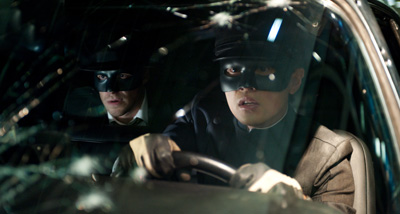 Guns in the hood - check. Guns in the trunk - check. Guns in the doors? "That was something that was not in the TV series and was one of our biggest challenges on the whole show: the suicide doors." McCarthy laughs. "One of the cars that was under consideration early on was a Lincoln Continental, which had suicide doors. Michel really liked those, so he asked if we could make the doors open in reverse on the front doors of the Imperial, and I said, 'Yeah, that's no problem at all.' Well, it turned out to be a tremendous engineering feat to make that happen."
Guns in the hood - check. Guns in the trunk - check. Guns in the doors? "That was something that was not in the TV series and was one of our biggest challenges on the whole show: the suicide doors." McCarthy laughs. "One of the cars that was under consideration early on was a Lincoln Continental, which had suicide doors. Michel really liked those, so he asked if we could make the doors open in reverse on the front doors of the Imperial, and I said, 'Yeah, that's no problem at all.' Well, it turned out to be a tremendous engineering feat to make that happen." But they did make it happen. Throughout the story, Kato tinkers with the Black Beauty, converting her from a classic car that perhaps made it out for the occasional Sunday spin to a fully loaded and quite suitable vehicle for the Green Hornet and his late night escapades with criminals. "Michel decided he wanted the car in the first half of the movie to have normal doors, and then on the car's second or third revision, it would have suicide doors. This created the need to have two separate models," McCarthy explains.
Building off the Chysler Imperial body style, which was produced in 1964, '65 and '66, McCarthy built different Black Beauties designed to do different things. Some had working dashboards, some did not. Some were used only for stunts and were installed with safety equipment and special seats. One of the cars sported guns which were hidden above the front bumpers and mechanically moved into position on top of the hood - this didn't allow for an engine. And all these were doubled, a version with regular doors and another with suicide doors.
The Imperial was a popular car in its day, so McCarthy and his team were able to locate the cars they needed without much trouble. Parts, however, were more of a concern. "They're great cars, but you can't get parts for them," he explains. "You can't buy brand new bumpers, you can't buy brand new trim. I sent two mechanics up to Montana - there's an Imperial graveyard there and we bought a bunch of stuff up there. We really scoured the entire United States for parts and pieces. Then, we could switch out parts between cars - for example, we could move a whole dash from one car to another in between takes."
One of the major Black Beauty stunts is at the climax of the film: Kato drives the Black Beauty into the elevator in the lobby of the Daily Sentinel - and when the elevator door closes, the Beauty is sheered in half. When the doors open on the newsroom floor, it drives through the bullpen.
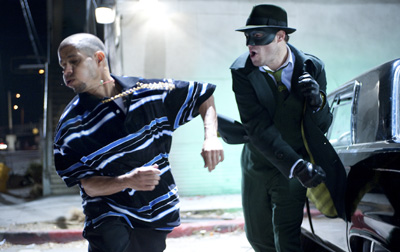 "That car was actually built by John Frazier's special effects crew," explains McCarthy. "It's a Cadillac Eldorado from the 1970s, front wheel drive. It had a rudder with a wheel in the back so the stunt driver could make sharp turns if needed to get through the set."
"That car was actually built by John Frazier's special effects crew," explains McCarthy. "It's a Cadillac Eldorado from the 1970s, front wheel drive. It had a rudder with a wheel in the back so the stunt driver could make sharp turns if needed to get through the set."To pull off the stunt, McCarthy needed three cars. "First, the car drives into the elevator and gets knocked off. Then, there's a stagnant piece of car that is in the elevator, and then there's another chunk of car that was the hero break-off piece. Watching the movie, you think, 'Oh, they just cut the car in half and drove away,' but there were three complete cars to make that one gag."
All the stunt cars, for instance, were drivable and "were basically built from scratch. We completely gutted the drive train and put in a late model 500-horse-power General Motors engine, different brakes, different suspension, different axle, complete wiring, everything."
Those stunt cars went through rigorous testing at the local racetrack, Hollywood Park. "We did about five weeks on these cars," McCarthy explains. "Stunts would come out and set up a course and would have guys do different maneuvers. It was great for us to really have a chance to thoroughly test these cars and see every weak link."
Even the actors got into the mix. "The most fun we had," he recalls, "was when Seth came down one day and just got crazy. He was in the car, there put a camera guy in the backseat, and he burned rubber and did donuts for hours. He loved it. He did great." Jay Chou had the same pleasure, and even Cameron Diaz, who doesn't drive in the film, came out and did "burnouts, flies and spins. Out of all our cast, she was probably the best driver," McCarthy grins.
Stunt coordinator Andy Armstrong says, "It's a 20 foot long car with a 27 foot normal turning circle, but with the aid of trick front breaks, we can turn the car around in 18 1/2 feet - it's spinning less than its own length. We jumped the car, we landed it in boxes. It's a better developed stunt car than anything I've ever built or have had built in any show."
BLACK BEAUTY SPECIFICATIONS
1964-66 Chrysler Imperial
GM Performance ZZ454 500hp Crate Motor
Race Trans Turbo 400 Manual Valve Body Transmission
Moser Ford 9-inch Rear Differential w/4.56 Gears & Detroit Locker
4-Wheel 12-Inch Disc Brakes, Twin Calipers in Rear for Stunts
Speedway Engineering Front & Rear Sway Bars
Art Carr Shifter
Hooker Headers
Flowmaster Mufflers
Coyes 20x10 Rear Wheels, 20x9 Front
Goodyear Tires
Off-Road Unlimited Rear Drop Springs
Tubular Panhard Bar and Traction Bars
Rebuilt Factor Front Suspension, Dropped 3 Inches
12-Gallon Jaz Fuel Cell
Demon 750CFM Carburetor
K&N Air Cleaner
MSD Distributor and 6AL Box
Be-Cool Aluminum Radiator
Twin Optima Batteries
Autometer Gauges
Grant Steering Wheel
Tommy Lee Steering Box
March Engine Accessory Drive System
Earls Transmission Cooler
Paint and Body Work by Jack's Auto Body
Clear Glass from Allen Auto Glass
Interior by Reubens Auto Upholstery
BLACK BEAUTY WEAPONS
Two .30-Caliber M1919 Browning Machine Guns - cartridge-fed, hood-mounted, retractable
Eight FIM-92A Stinger Missiles - front bumper loaded
Four FIM-92A Stinger Missiles - rear bumper loaded
One M2 Grill mounted Flamethrower - modified
Two Benelli M2 20 Gauge Shotguns loaded with non-lethal, kinetic impact munitions rifles (rubber bullets / beanbags) - mounted in the light bezels
Six AR-15 12-Gauge modified door guns - inset 3 per front suicide door
Two Retractable front wheel anti-riot spikes
One .30-Caliber M1919A6 Browning Machine Gun on tripod mount - trunk
Passenger glove box weapons control with vector graphics
Steering wheel d-pad targeting and fire controls
BLACK BEAUTY ACCESSORIES
Front-end suicide doors
Front facing Green HID lamps with Somatosensory Amplification - 6,000,000 candlepower
Cataclysmic event front ejector seat system
Sony NV-U94T GPS receiver
Possio Greta GSM Mobile Fax Machine
Sony PS-LX250H belt-driven turntable
Danby DIM1524W Ice Maker
Rear door child safety locks
BLACK BEAUTY ARMOR
Threat level NIJ III A Armoring
Windscreen and Side Windows in Transparent Ballistic-Certified Multilayer Industrial Polycarbonate Glass
Roof, Floor, Front & Rear Panels, Side Panels & Doors Protected with 4.6mm ARMOX Ballistic Steel, Plasma Cut and Welded to Avoid Rust and Penetration
Hood & Rear Upper Panel Protected with 12mm KEVLAR plates
Overlap Protection on Windows Upper Perimeter and Critical Areas Against Angle Shot
Run Flat Inserts on Wheels with Tire Pressure Defensive Regulation System
ABOUT THE ACTION UNIT & STUNTS
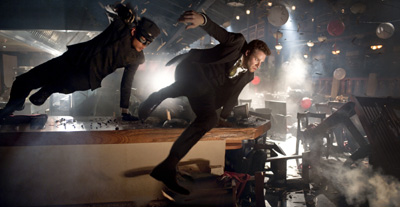 Vic Armstrong, an Academy Award winner, veteran stuntman, and the film's second unit director/stunt coordinator, says that developing an action sequence takes time - as if he is a conductor of a choir, combining many different voices into a harmonious whole. "The first thing is you talk to the production, the producers, the director. And you decide what type of car chase it's going be, how long you want it to be, how violent you want it to be, how original it's going be - everybody wants original stuff - and what points we want to emphasize in it. And the emphasis in this movie was to show all the gags that the Black Beauty can achieve."
Vic Armstrong, an Academy Award winner, veteran stuntman, and the film's second unit director/stunt coordinator, says that developing an action sequence takes time - as if he is a conductor of a choir, combining many different voices into a harmonious whole. "The first thing is you talk to the production, the producers, the director. And you decide what type of car chase it's going be, how long you want it to be, how violent you want it to be, how original it's going be - everybody wants original stuff - and what points we want to emphasize in it. And the emphasis in this movie was to show all the gags that the Black Beauty can achieve."But the filmmakers also intended the action sequences to move the character arcs forward. "We had to show that Kato is really an excellent driver and technician," Armstrong says. "Then you have Britt, who's not Mr. Magoo, but little things backfire on him. Things go wrong when he handles them, more often than not. We had to take all of that into account."
Vic Armstrong's final challenge was to keep the tone of the other sequences in mind. While the action sequences couldn't be played for laughs, neither could they be so serious as to seem like they belong in a different kind of film. "I find having the comedy aspect was a great relief and offered great freedom for me. It opened up what I could do," he says. "You can get away with more, pictorially, and push the envelope."
Working with a visual artist like Michel Gondry was an unusual experience. "Some of his ideas are off the wall," says Vic Armstrong. "He'd give me a rough sketch of how he saw a sequence in his mind, and I'd interpret that into what we could accomplish in real life."
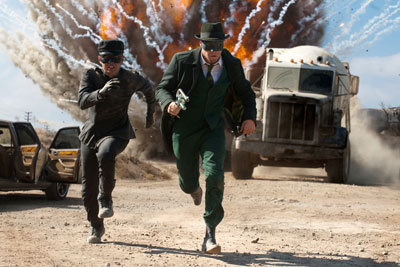 The action centerpiece of the film's climax is a chase scene down an LA freeway, with about 10 cars filled with bad guys chasing down the Black Beauty. Each of those cars would have to be disposed of in a different way. Vic Armstrong says that he let the location determine the structure of the chase. "Rather than dreaming up some fantastical chase and then searching Los Angeles to find locations that suit it, I like to look at locations, let the location speak to me and give me some idea of what can happen there. So we searched all around LA until I came across this mall down in Hawthorne, which for me had a lot of plusses."
The action centerpiece of the film's climax is a chase scene down an LA freeway, with about 10 cars filled with bad guys chasing down the Black Beauty. Each of those cars would have to be disposed of in a different way. Vic Armstrong says that he let the location determine the structure of the chase. "Rather than dreaming up some fantastical chase and then searching Los Angeles to find locations that suit it, I like to look at locations, let the location speak to me and give me some idea of what can happen there. So we searched all around LA until I came across this mall down in Hawthorne, which for me had a lot of plusses."Since the mall was not in operation, the action unit could have complete control of the location. The roof was about quarter mile long, and was a parking structure," says Vic Armstrong. "I turned that into a freeway by putting down K-rail." Often times when using a real freeway as a location, productions are only offered about quarter of a mile, the same the parking structure would provide. But by creating a freeway at the mall, production could avoid other issues such as limited time for load-in and shooting as well as traffic control. Additionally, the action unit was able to utilize the inside of the parking lot, the adjacent rows outside, and circular ramps.
With Vic's brother, Andy Armstrong, acting as stunt coordinator on the first unit, and Vic's son, Scott, as second unit stunt coordinator and a stunt player on both units, the marriage of first and second units became seamless. "We discussed all the different types of explosions and crashes we could do with the cars," says Vic Armstrong. For instance, "My brother, Andy, did the first cannon, which is an explosive device under a car, which flips it."
Between the two units, they also covered a pipe ramp where Scott Armstrong drove head-on into a bus, going through and out the other side, and an end over cannon where James Armstrong (nephew to Vic) gets shot in the rear end and flips end over end.
"We had some stunning drivers," Vic Armstrong enthuses. One of the best of all, he says, was "a nice big jump with Chudnofsky's vehicle - we blew two tires and still kept it straight and drove out of the shot. It was just stunning."
"The third act of this picture is just absolutely nonstop action," Vic Armstrong concludes, "and I think we rose to the challenge. We've done stuff that's often more spectacular than he at first expected."
HOW KATO FIGHTS .... IN KATO-VISION
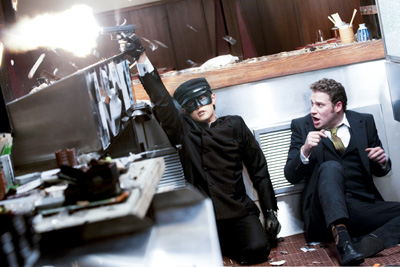 In the "Green Hornet" television series, Bruce Lee made both himself and Kato international stars. Because of that, the filmmakers were aware that there would be certain expectations for Kato's fight sequences. As the film's fight stunt coordinator, Jeff Imada, says, "To me, the present day Kato either had to follow Bruce Lee but be better than Bruce Lee, or go completely the other direction. I think that's what Michel wanted to do - our Kato would not have any martial arts background."
In the "Green Hornet" television series, Bruce Lee made both himself and Kato international stars. Because of that, the filmmakers were aware that there would be certain expectations for Kato's fight sequences. As the film's fight stunt coordinator, Jeff Imada, says, "To me, the present day Kato either had to follow Bruce Lee but be better than Bruce Lee, or go completely the other direction. I think that's what Michel wanted to do - our Kato would not have any martial arts background."In Jay Chou, the filmmakers found someone who "understands body mechanics," Jeff Imada continues, "and he can captivate the screen. He's got a great presence."
Jay Chou began his training before production began. "He was very interested in training," says Jeff Imada, "and wanted to learn as much as he could in the time we had."
"Because he has a dance background, Jay picks up choreography very quickly," says Jeff Imada. For instance, on one occasion, after watching a run through of a fight scene with stunt players, Jay Chou said, "Let me try." As Jeff Imada recalls, he proceeded to get "half-way through the fight on his own without any prompting. He just visually picked it up and went through it. He understands how to flow from one thing to the next."
Still, even though Jay Chou sought to make the character his own, it seemed appropriate to give a tip-of-the-chauffeur's-cap to Lee, in subtle ways. "Jay is definitely a big Bruce Lee fan, and there were certain elements he's trying to carry over," says Jeff Imada. "His favorite thing is, 'Well, that's cool.' He wants the cool factor. As long as it has a cool factor, he's happy about it."
One example, and one of Jay Chou's favorite moves, were the "hand trapping movements," Jeff Imada continues. "People saw Bruce Lee do that many years ago and Jay likes that, the quick hand motions and being able to take people out very quickly."
Jeff Imada's resume includes films such as Armageddon, Rush Hour, Fight Club, Mr. & Mrs. Smith and The Bourne Ultimatum. On The Green Hornet, he was asked to emphasize the comedic elements of the fight sequences, but in a very specific way. "It's not slapstick," Jeff Imada explains. "There's still a lot of seriousness in the story. But a lot of comedy is physical, and I approached the physical comedy by using things in the environment for things other than their intention. For instance, in the Britt and Kato fight, we got a lot of physical comedy in there by using everyday items that are in Britt's bungalow."
"I think that's my favorite thing," says Michel Gondry. "The fight is gritty and mean but funny at the same time. It's very well-orchestrated - we use everything in the room. It flies in every direction but it's still very realistic. We wanted to maintain a good level of comedy during the action. Even when everything is blowing up around them, it's fun to watch."
But story always comes first. The action, just like the comedy, must serve the story and the characters. "You have to control how the fight escalates and how it tapers off so that in doing all this physical action, it still tells a story, just the same as dialogue," says Jeff Imada.
What would really set Kato's fight sequences apart - and put Michel Gondry's singular signature on the film - would come to be known as Kato-Vision. Jeff Imada explains, "Michel basically wanted to show the audience how Kato saw things - as far as any kind of danger or action." This point-of-view perspective would allow the audience to see how Kato's brain takes in a threatening situation as it unfolds.
"When Kato's heart starts beating fast, time slows down for him and he assesses the danger," says Michel Gondry. Ever have the feeling - in that moment between sleep and waking - that you've suddenly solved the most complex problems in the world? "That's called hypnotic hallucination, and Kato can make himself go into that state at critical moments. The objects he'll need in the fight are highlighted, and every character he's going to take out is projected. He also has a spacial memory - he can recall immense amounts of data and map it all in his brain. Kato's fighting is pretty impressive because he knows where everything is and how he is going to use it."
What's more, when time slows down, Kato moves at super-human speeds, quickly taking on multiple bad guys in the same frame in which they move in slow-motion. Very early on, as part of his presentation to Neal H. Moritz and Seth Rogen showcasing his vision for the film, Michel Gondry presented a test that he created with the Phantom Camera, a digital camera capable of shooting thousands of frames per second. The test showed two men fighting at different speeds - one seemingly stuck in place and the other moving very quickly.
Kato-Vision is not only the kind of signature imagery that audiences expect from Michel Gondry - Jeff Imada feels it adds to the audience experience by giving them the full impact of a fight sequence as well as the melodic beauty of martial arts. "Sometimes you want to see everything happen in real time and see how good the person is. Other times you appreciate the movements, because you can see the reactions and how hard people are getting hit or falling in slow motion," says Jeff Imada.
The 3D really shines in the Kato-Vision sequences. "The way that Michel envisioned Kato-Vision from the very beginning opens up the opportunity for Michel to go crazy with 3D," says Sony 3D Technology Center stereographer Rob Engle. "Michel's idea was for the 3D to give you a hyper-reality idea. All of the elements that make up Kato-Vision - the idea that we are seeing the world as Kato sees it the idea that time is slowing down for him - are heightened by the 3D experience, by the idea that you're actually there and experiencing that world."
MORE





